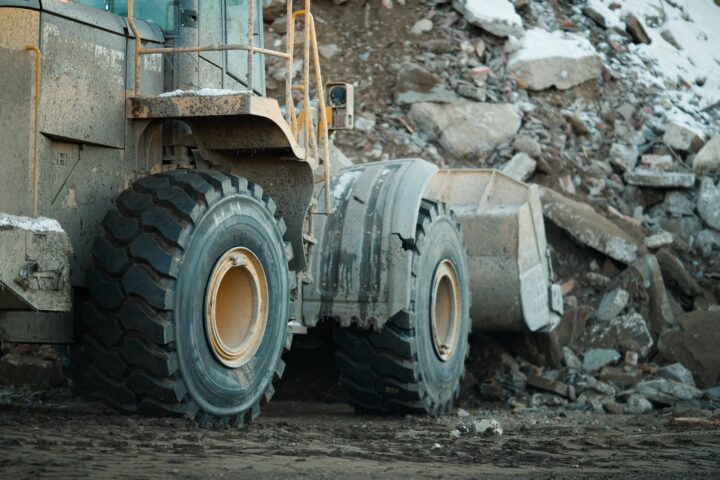COOKIES ON THE YOKOHAMA ATG SITE
We use cookies on this site to enhance your user experience. By clicking any link on this page, you are giving your consent for Yokohama ATG to set cookies.
October 4, 2023 << Back to Blog

October 4, 2023
Premature tire wear on wheel loaders can break budgets and eat into profits. Tires are generally the most expensive consumable part on wheel loaders and extending their life can provide numerous benefits, including improving efficiency (of both operators and equipment), lowering maintenance costs and reducing downtime.
Reap the rewards of long-lasting tires with these tips on how to improve the life of wheel loader tires.
Ensuring tires are inflated to the proper pressure is the most significant step you can take toward maximizing tire life—both overinflated and underinflated tires can shorten service life and decrease performance.
Get in the habit of checking the inflation of your tires regularly and adjust accordingly.
To keep your tires inflated to the proper pressure, you need to know the right pressure to run them at. Consult the tire manufacturer’s load/pressure tables or work with your local tire dealer to calculate the optimal tire pressure for your application, considering factors like the weight of your equipment, the loads it will carry, and the speeds it will travel.
Choosing the right tire for the right job is a proven strategy for maximizing tire life, making it imperative to match tires to the applications they’ll engage in. For example, a wheel loader working on surfaces like sand and mud while navigating a massive construction site is better equipped with a tire featuring a high-traction pattern, like the Yokohama RL45. Conversely, a wheel loader working on the abrasive, puncture-prone terrain of a mine or quarry will benefit from opting for a highly protective rock-treaded tire like the Yokohama RL52.
Frequently inspecting tires can catch problems early—helping to prevent costly repairs and unforeseen downtime. It can also improve efficiency at the worksite and the safety of operators. When checking tires, look for:
In order to ensure thorough inspection and enhance tire life, make sure to keep tires clean. Substances like salt and mud can obscure potential issues and lead to faster tire wear.
Spinning tires will accelerate wear, burn unnecessary fuel, and ultimately cost fleets money. Make sure to train operators, take advantage of traction control (if a wheel loader is equipped with it), and use hydraulics and the skillful use of the bucket to create traction when picking up a load.
Chains can provide additional protection and extend tire life when working in applications rife with damage-causing obstacles, like applications on hard, abrasive granite.
Whether it’s a sharp rock at a quarry or a steep curb on a large construction site, avoiding potential hazards is one of the best steps operators can take to reduce downtime and increase the service life of tires. Similarly, keeping traffic paths free of potentially damaging debris is another smart strategy for longer-lasting tires.
It may seem counterintuitive, but slowing down and ensuring you don’t hit anything can speed up the time it takes to complete a job.
In load, haul and dump applications, consider how the traffic pattern will affect tire life. Loaders traveling too far in the hauling cycle can cause heat buildup in their tires and shorten their life while sharp turns scrub away valuable rubber. Extend the life of wheel loader tires by minimizing their transport distances and sharp turns they’re required to make when possible.
For some operations, retreading is an excellent way to extend the life of wheel loader tires with a minor investment when applicable and appropriate. Loader tires are built with robust carcasses and although a tread might wear out, a tire can have a lot of life left in it. High-quality construction, a premium build, and features like steel belts all combine to improve the retreadability of a tire.
Interested in retreading? Work with your local tire dealer to see if it’s a viable option for your operation.
Just like vehicle tires, wheel loader tires benefit from regular rotation. Tires wear differently depending on their position on a piece of equipment. Periodically moving them helps prevent straining specific areas and extends tire life.
Yokohama has a wheel loader tire for nearly every application. For example, L-5 tires like the RL51 and RL52 are ideal for jobs at large surface mines—preferably at the face—or underground applications. L-4 tires like the RL45 are used on heavy-duty construction sites or quarries, while L-3 tires like the RB31 are a great match for multipurpose loaders working on construction and quarry sites.
All the tires above are all-steel radials, which deliver high performance, comfortable operation, excellent retreadability, and long service life—all of which, in the end, help businesses spend less on tires and put more money in their pockets.

Benefits of Yokohama Radial Wheel Loader Tires
• Application-specific to meet the real-world challenges facing tires
• Premium casings for long service life
• All-steel construction for protection
• Increased operator comfort for improved productivity
• Special compounds formulated to resist cuts, improve heat dissipation, and reduce wear
• Premium construction for improved retreadability
19-Jul-2024
27-Jun-2024
24-Jun-2024
05-Jun-2024
16-May-2024
01-Dec-2023